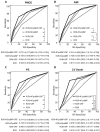Preoperative NT-proBNP and CRP predict perioperative major cardiovascular events in non-cardiac surgery
- PMID: 19861299
- PMCID: PMC2791233
- DOI: 10.1136/hrt.2009.181388
Preoperative NT-proBNP and CRP predict perioperative major cardiovascular events in non-cardiac surgery
Abstract
Objective: To investigate whether simple and non-invasive measurement of N-terminal pro-brain natriuretic peptide (NT-proBNP) and/or C-reactive protein (CRP) can predict perioperative major cardiovascular event (PMCE).
Design: Prospective, single-centre, cohort study.
Setting: A 1900-bed tertiary-care university hospital in Seoul, Korea Design and
Patients: The predictive power of NT-proBNP, CRP and Revised Cardiac Risk Index (RCRI) for the risk of PMCE (myocardial infarction, pulmonary oedema or cardiovascular death) were evaluated from a prospective cohort of 2054 elective major non-cardiac surgery patients. Optimal cut-off values were derived from receiver operating characteristic curve (ROC) analysis.
Main outcome measurement: PMCE (myocardial infarction, pulmonary oedema or cardiovascular death) within postoperative 30 days.
Results: PMCE developed in a total of 290 patients (14.1%). Each increasing quartile of NT-proBNP or CRP level was associated with a greater risk of PMCE after adjustment for traditional clinical risk factors. The relative risk (RR) of highest versus lowest quartile was 5.2 for NT-proBNP (p<0.001) and 3.7 for CRP (p<0.001). Both NT-proBNP (cut-off = 301 ng/l) and CRP (cut-off = 3.4 mg/l) predicted PMCE better than RCRI (cut-off = 2) by ROC analysis (p<0.001). Moreover, the predictive power of RCRI (adjusted RR = 1.5) could be improved significantly by addition of CRP and NT-proBNP to RCRI (adjusted RR 4.6) (p<0.001).
Conclusions: High preoperative NT-proBNP or CRP is a strong and independent predictor of perioperative major cardiovascular event in non-cardiac surgery. The predictive power of current clinical risk evaluation system would be strengthened by these biomarkers.
Conflict of interest statement
Figures



Comment in
-
Preoperative NT-proBNP and CRP predict perioperative major cardiovascular events in non-cardiac surgery.Heart. 2010 Aug;96(15):1254; author reply 1254. doi: 10.1136/hrt.2010.198580. Heart. 2010. PMID: 20639243 No abstract available.
References
-
- Goldman L, Caldera DL, Nussbaum SR, et al. Multifactorial index of cardiac risk in noncardiac surgical procedures. N Engl J Med 1977;297:845–50 - PubMed
-
- Detsky AS, Abrams HB, Forbath N, et al. Cardiac assessment for patients undergoing noncardiac surgery. A multifactorial clinical risk index. Arch Intern Med 1986;146:2131–4 - PubMed
-
- Lee TH, Marcantonio ER, Mangione CM, et al. Derivation and prospective validation of a simple index for prediction of cardiac risk of major noncardiac surgery. Circulation 1999;100:1043–9 - PubMed
-
- Kertai MD, Boersma E, Klein J, et al. Optimizing the prediction of perioperative mortality in vascular surgery by using a customized probability model. Arch Intern Med 2005;165:898–904 - PubMed
Publication types
MeSH terms
Substances
LinkOut - more resources
Full Text Sources
Medical
Research Materials
Miscellaneous
